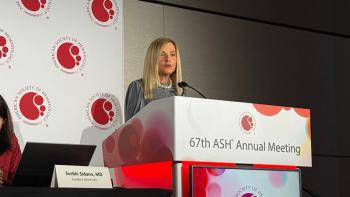
Adverse Effects of Hospitalization for Vaso-Occlusive Crises Persist for 12 Months
Children with sickle cell disease who require hospitalization for vaso-occlusive crises can experience adverse effects for up to 12 months following hospitalization, a study found.
Children who are diagnosed with sickle cell disease (
SCD affects millions of people worldwide and is the most common hemoglobinopathy. Vaso-occlusion is 1 of the many chronic complications of SCD, which can cause acute pain if combined with impaired oxygen supply and reperfusion of injured tissues. Past research has indicated that VOC frequency typically ranges from 0 to 18 per year and can occur in every part of the body or be more localized to the chest, back, or abdomen.
The aim of the present real-world study was to determine the impact of hospitalization for VOC on HRQoL among children who have sickle-cell disease up to a year after hospitalization.
The study used a retrospective cohort design to evaluate this relationship. Participants were eligible if they were aged between 8 and 18 years, had a confirmed diagnosis of SCD, and received care at Emma Children’s Hospital in Amsterdam University Medical Centers. Patients were asked to complete the Pediatric Quality of Life Inventory 4.0 Generic core scales (PedsQL 4.0) at least once a year. Children were eligible if they had completed at least 2 PedsQL forms between January 2012 and September 2021. All demographic and disease-related characteristics were collected from electronic health records and self-reported HRQoL was collected through the PedsQL form.
There were 94 patients included in the study. There was a total follow-up duration of 451 patient-years and a median (IQR) follow-up time of 4.0 (2.0-6.0) years. The PedsQL was completed 455 times from January 2012 to September 2021 by the included patients, 237 times in the non-hospitalized group and 218 times in the hospitalized group.
The median age of the patient at the first completion of PedsQL was 11.8 (9.3-14.1) years and 64% of the patients identified as male. A total of 37 patients had at least one hospitalization for VOC and 57 had no hospitalization for VOC prior to measuring HRQoL.
The occurrence of hospitalization was negatively correlated with HRQoL at 3, 6, 9, and 12 months after hospitalizations. Patients had decreased total HRQoL from 4.8 at 3 months to 3.2 at 12 months compared with non-hospitalized patients. The most pronounced decrease in HRQoL came at 3 months after hospitalization, with decreases totaling between 3.3 and 5.8 points, except in physical functioning. The physical functioning score was most impacted at 6 months after hospitalization, marked by a decrease of 6.1 points.
There was a decrease in HRQoL for every hospitalization after the first, with total HRQoL decreasing by 2.3 points for every hospitalization in 12 months compared with children who did not have additional hospitalizations. A decrease of 2.7 points in physical functioning and 2.6 in school functioning was also found for every hospitalization.
A total of 15 (41%) of the 37 children who had been admitted for a VOC during the follow-up period had had a severe hospitalization; 32% had a hospitalization classified as mild. The severity of hospitalization had a negative effect on HRQoL at 3 months after hospitalization, but this was not significant.
There were some limitations to this study. Patients with SCD who manage their VOCs at home were not accounted for in this study. The school functioning subscale was not found to have moderate/good reliability. Patients without hospitalization completed the PedsQL more often than those with hospitalization, and not all children filled out the PedsQL regularly. All of these limitations could have resulted in selection bias in the study population.
The researchers concluded that their study suggests a negative impact of hospitalization lasting at least up to 12 months in children with SCD, and that preventing VOCs and giving patients optimal attention after VOCs should be the primary focus of health care providers.
Reference
Vuong C, Moussa I, van Muilekom MM, et al. Impact of hospitalization for vaso-occlusive crisis on health-related quality of life in children with sickle cell disease. Pediatr Blood Cancer. Published online September 25, 2023. doi:10.1002/pbc.30691
Newsletter
Stay ahead of policy, cost, and value—subscribe to AJMC for expert insights at the intersection of clinical care and health economics.









































